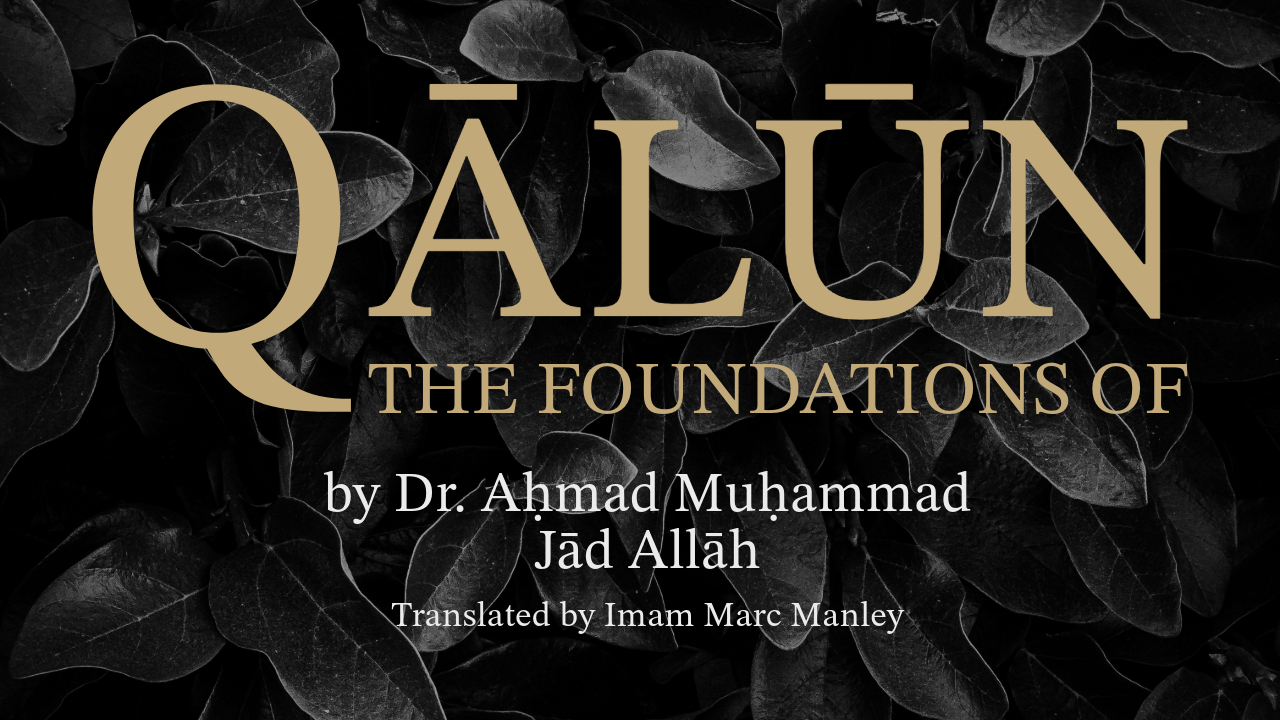
﷽
الحمد لله المفيض الخيرات والوهاب البركات وصلى وسلم وبارك على سيد المرسلين وعلى آله وصحبه وبعد
The Qur’ān is the book, the text, at the very heart of Muslim life. Amongst the many noble sciences of the Qur’ān is the art and science of its recitation. I will be presenting here a work on the fundamental rules related to one of the Recitations of the Qur’ān, that which is know as Qālūn. This series is a translation of the work by Dr. Aḥmad Muḥammad Jād Allāh (د. أحمد محمد جاد الله), may Allāh preserve him, entitled The Fundamentals of Qālūn from the Shāṭibiyyah Method – Question and Answer (أُصُولُ رِوَايَةِ قَالُونْ مِن طَرِيقِ الشَّاطِبِيَّة – سُؤَالٌ وَجَوَابٌ). Dr. Jād Allāh is Professor of Arabic and Qur’ānic Sciences at Omar al-Mukhtar University, Libya, as well as a member of the Qur’ān Review Committee. This work serves as an introduction to the recitation of Imām Qālūn, one of the 20 authentic ways to recite the Qur’ān (riwāyāt).
My reason for writing this translation series is many but I’ll list just a few here. First, Qālūn as a recitation, is very strong from an isnād and ‘ilm al-riwāyah point of view (chain of transmission and narration). Second, Qālūn is an easier recitation, in my opinion, when compared to other recitations including the recitation named after Imām Warsh – who was also a student of Imām Nāfi’ (the teacher of both Imams Warsh and Qālūn) – due to Qālūn having not only fewer rules, making it sound closer to regular speech, but also having fewer long vowels (mudūd). This helps to facilitate ease in new students studying the Qur’ān. And finally third, the recitation marries well with the study of Mālikī Fiqh here at Middle Ground, as it is the recitation that historically has been relied upon by the Mālikīyyah throughout the centuries in terms of academic study (even if Warsh gained popularity amongst the Mālikīyyah today) as well as with our tafsīr class, Understanding the Qur’ān, in which the two primary tafsīrs we’ve been reading, Ibn Juzayy’s al-Tashīl li ‘Ulūm al-Tanzīl and Imām al-Shawkānī’s Fatḥ al-Qadīr rely and primarily reference the recitation of Qālūn.
About Imām Nāfi’
He is Nāfi’ bin ‘Abd al-Raḥmān bin Abī Nu’aym, Abū Ruwaym, al-Laythī – having been their freed slave – one of the eminent scholars and one of The Seven Reciters (al-Qurrā’ al-Sab’ah). He read the Qur’ān and took it from over seventy of the Companion’s Successors (Tābi’ūn), with Imām Mālik having studied under him. He became the leading figure in Qur’ānic recitation in Madīnah and passed away in the year 169 AH (from Shaykh Aḥmad Khalīl al-Zarrūq’s Uṣūl Riwāyah Qālūn min Ṭarīq al-Shāṭibiyyah).
About Imām Qālūn
He is Qālūn, ‘Īsā bin Mīnā’ bin Wardān, the freed slave of Banū Zuhrah, Abū Mūsā. It is said that he was the foster/stepson of Nāfi’, and he had a special association with him. It was Nāfi’ who gave him the nickname “Qālūn” because of his excellent recitation, as qālūn means “excellent” in Byzantine Greek. He was born in the year 120 AH and passed away in 220 AH, according to the most accurate report.
About the al-Shāṭibiyyah Method
The al-Shāṭibiyyah Method is attributed to Muḥammad bin Hārūn al-Marwanī, Abū Yashīṭ, who studied under Qālūn and was one of his most prominent students. He passed away in the year 258 AH.
al-Shāṭibiyyah is a poem by Imām al-Shāṭibī, al-Qāsim bin Fīrrah, Abū al-Qāsim, “The Blind”. He was born in the year 538 AH, was skilled in many fields, and possessed vast knowledge. His poem on the Seven Recitations, “Ḥirz al-Amānī wa Wajh al-Tahānī (حِرز الأماني ووجه التهاني)”, which became widely known, in which he versified “al-Taysīr” by al-Dānī. He settled in Egypt and passed away there in the year 590 AH.
May Allāh bless and preserve Dr. Aḥmad Muḥammad Jād Allāh for his work to illuminate and elucidate the sciences of the Qur’ān.
The Rules of Qālūn – Question & Answer
﷽
Question Number One: What is the preferred formula for seeking refuge in Allāh (ta’awwudh/التعوّذ) and are other formulas allowed?
Answer: The preferred and well-known formula is:
“A’ūdhu billahi min al-shayṭān al-rajīm/أعوذ بالله من الشيطان الرجيم” (I seek refuge in Allah from the accursed devil) because it is the formula mentioned in Sūrah al-Naḥl. Other formulas mentioned by scholars of Qur’ānic recitation are also permissible, such as:
“A’ūdhu billahi al-Samī’ al-‘Ālīm min al-shayṭān al-rajīm/أعوذ بالله السميع العليم من الشيطان الرجيم” (I seek refuge in Allah, the All-Hearing, the All-Knowing, from the accursed devil),
or “A’ūdhu billahi al-‘Aḍhīm min al-shayṭān al-rajīm/أعوذ بالله العظيم من الشيطان الرجيم” (I seek refuge in Allāh, the Magnificent, from the accursed devil),
or “A’udhu billahi min al-shayṭān al-rajīm, innahu huwa al-Samī’ al-‘Ālīm/أعوذ بالله من الشيطان الرجيم، إنّه هو السميع العليم” (I seek refuge in Allah from the accursed devil; indeed, He is the All-Hearing, the All-Knowing), among other formulas.
We’ll be posting Question Number Two shortly, in shā’ Allāh.

